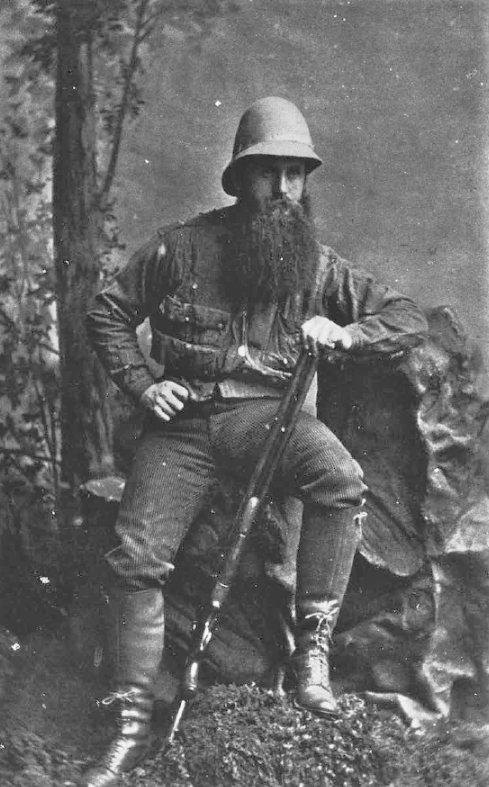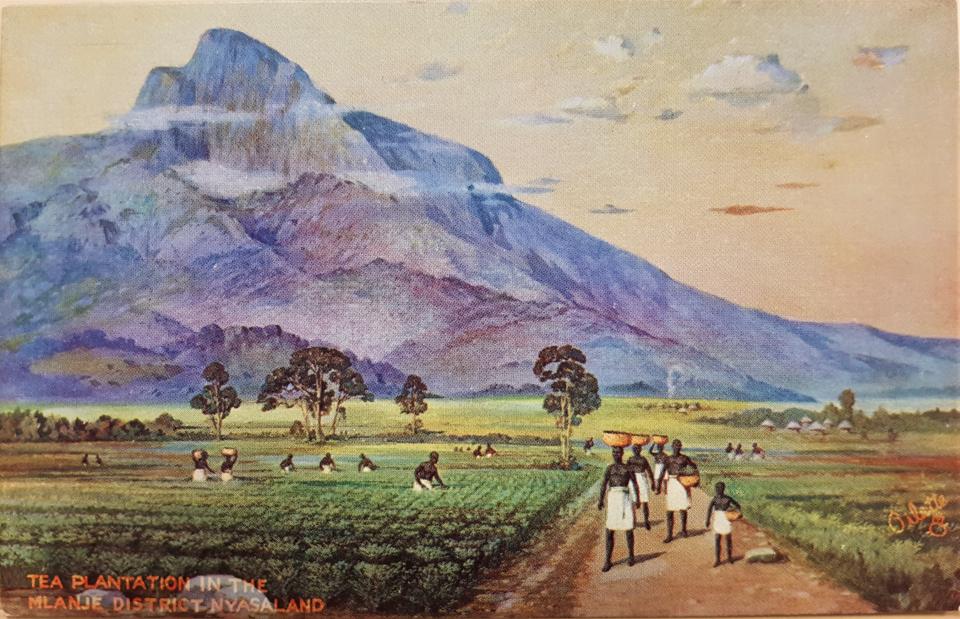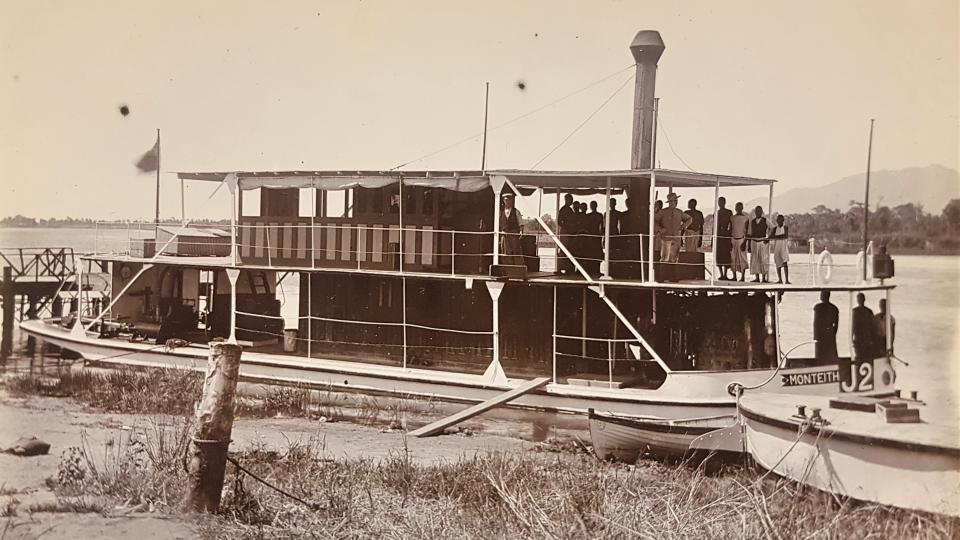The African Lakes Company (ALC) was formed in 1878 to navigate “the rivers and lakes of Central Africa, and especially of those rivers and lakes which communicate with the Indian Ocean by the River Zambezi and the River Zambezi itself, with a view to develop the trade and resources of the country, and to encourage legitimate traffic amongst the natives.”

By 1900, the African Lakes Corporation was the key operator of transport services from the coast along the Zembezi and Tchiri rivers into Nyasaland.
By 1900, the African Lakes Corporation was the key operator of transport services from the coast along the Zembezi and Tchiri rivers into Nyasaland.
Artwork by African Lakes Corporation, c. 1900.
 This work is licensed under a Creative Commons Public Domain Mark 1.0 License.
This work is licensed under a Creative Commons Public Domain Mark 1.0 License.
The expansion of European empires into Africa was aided by navigable river networks that made efficient and cheap water transport possible. Rivers, however, are not constant and predictable, as the ALC would discover in colonial Nyasaland (now Malawi).
Inspired by David Livingstone, members of the Free Church of Scotland Foreign Missions Committee in Glasgow established the ALC to undermine the slave trade in central Africa and to connect local industry with overseas markets. Their agents would be brothers John and Frederick Moir.
The Moirs arrived at the mouth of the Kwakwa River, near Quelimane in present-day Mozambique, in August 1878. Frederick Moir noted that “The banks of the river were covered in beautiful green trees and shrubs … We seemed to be in a tropical paradise,” but later observed with disappointment: “What a change when the tide had ebbed! A stretch of several hundred feet of slimy mud lay before the town.” He described the river as “muddy and obnoxious to eye and nose”. Moir said that it was this “fringe of malarial swamp … which had been so great a barrier against the exploration and colonization of the interior” (Moir 1923).

Photographed here in 1885, Frederick L. M. Moir was an African Lakes Corporation agent in Nyasaland between 1878 and 1891.
Photographed here in 1885, Frederick L. M. Moir was an African Lakes Corporation agent in Nyasaland between 1878 and 1891.
Unknown photographer, 1885.
Originally published in Frederick L. M. Moir, After Livingstone: An African Trade Romance, London: Hodder and Stoughton, 1923.
 This work is licensed under a Creative Commons Public Domain Mark 1.0 License.
This work is licensed under a Creative Commons Public Domain Mark 1.0 License.
That steamboat transport would meet with difficulties should not have been surprising. Livingstone’s Zembezi expedition between 1858 and 1864 had soon discovered that the Shire, or Tchiri, River had many faults as a navigable waterway. Nearly 50 kilometers of cataracts and shifting mud banks divided the Upper and Lower Tchiri, and these grew during the dry season, rendering the waterway unusable by steamers.
Livingstone and his successors nevertheless believed a Zembezi-Tchiri river route could become a key artery for international trade from the Shire Highlands to the coast, perhaps because they had visited the region when river levels were particularly high. From the late nineteenth century, however, lake levels were in decline across eastern Africa due to climatic changes. Lake Nyasa’s levels dropped and would not rise to similar levels until the 1930s, by which time significant river transport had come to an end altogether.
As water levels dropped, by the 1890s Katunga (Chikwawa) was abandoned as a port. The function of its successor at Chiromo was also threatened, and in 1903 steamers from Chinde had to unload their cargoes at a Portuguese station, over 60 kilometers to the south of the Mozambique-Nyasaland border. The river in the dry seasons was now transformed into a series of shallow pools and sandbanks. The road from Katunga to the commercial centre of Blantyre was prone to disintegration in rains, while Tsetse flies and steep terrain made the use of oxen nearly impossible.

A postcard from 1930 shows a tea plantation in the Mlanje district. The difficulty planters had in transporting cash crops provided some impetus to improve transport infrastructure in Nyasaland.
A postcard from 1930 shows a tea plantation in the Mlanje district. The difficulty planters had in transporting cash crops provided some impetus to improve transport infrastructure in Nyasaland.
Artwork by D. L. Constantinides, c. 1930.
Courtesy of University of Glasgow Archive Services (UGC 193/1/13/4/1).
 This work is licensed under a Creative Commons Public Domain Mark 1.0 License.
This work is licensed under a Creative Commons Public Domain Mark 1.0 License.
For the ALC, unreliable rivers led to financial losses. Its 1898 annual report informed shareholders that returns “have been considerably diminished by exceptional expenditure and loss in the transport department … the rivers fell during 1895 to so low a point that several transhipments were necessary before goods reached Mandala, these having, in some cases, to be transported several days’ journey by native carriers.” The reliance on labor made Malawi’s transport system extremely expensive. The human cost was considerable too: many of the carriers died.
River levels continued to drop. In 1912, one European observer wrote of the Tchiri that the “river, upper and lower, year by year goes from bad to worse—indeed it can hardly be worse for there is now at the end of this dry season no river at all, only here and there pools of water separated by sand-banks or barriers of reeds and cabbage plant, the water being only a few inches in depth” (Life and Work in British Central Africa, September 1905, quoted in Mandala 2006).

African Lakes Corporation steamers such as this were the primary form of both freight and passenger transport until the coming of railways.
African Lakes Corporation steamers such as this were the primary form of both freight and passenger transport until the coming of railways.
Unknown photographer, Africans Lakes Corporation, n.d.
Courtesy of University of Glasgow Archive Services (UGC 193/1/13/4/18).
 This work is licensed under a Creative Commons Public Domain Mark 1.0 License.
This work is licensed under a Creative Commons Public Domain Mark 1.0 License.
The British Foreign Office saw no justification for investing in railways in what it thought was a region with very little importance. A private railway completed in 1908 was poorly constructed. Further railways were opened which ultimately, if inefficiently, connected Nyasaland by rail to the coast at Beira in present-day Mozambique. By 1922, the ALC had sold off its boats and transport infrastructure. Nevertheless, in 1924, one writer observed that, despite the railways, “Nyasaland and the north-eastern division of Northern Rhodesia is still one of the least accessible portions of the British Empire” (Lepper 1924).
The ALC’s initial emphasis on water transport in a part of the African continent with increasingly unreliable river levels—and a lack of imperial investment in road and rail transport—was one reason behind Malawi having, by 1915, a lower wage economy, less capital investment, and less foreign trade than its neighbors. The British had, more broadly, struggled to develop a self-sustaining colony. Confined to unreliable river transport in its formative decades, the landlocked nation had an inefficient transport system that formed a long-lasting constraint on its capacity for overseas trade. By the time of Malawi’s independence in 1964, it was one of the poorest countries in the world.
How to cite
Wilkie, Benjamin. “‘What a Change When the Tide had Ebbed!’: Rivers, Empire, and a Scottish Transport Company in Colonial Malawi.” Environment & Society Portal, Arcadia (Spring 2020), no. 18. Rachel Carson Center for Environment and Society. https://doi.org/10.5282/rcc/9040.
ISSN 2199-3408
Environment & Society Portal, Arcadia
 This work is licensed under a Creative Commons Attribution 4.0 International License.
This work is licensed under a Creative Commons Attribution 4.0 International License.
2020 Benjamin Wilkie
This refers only to the text and does not include any image rights.
Please click on an image to view its individual rights status.
- Butlin, Robin A. Geographies of Empire: European Empires and Colonies c.1880–1960. Cambridge: Cambridge University Press, 2009.
- Lepper, G. H. “Nyasaland’s Transport Problem.” The English Review 39 (1924): 450–58.
- Macmillan, Hugh. “The Origins and Development of the African Lakes Company, 1878–1908.” Ph.D. diss., University of Edinburgh, 1970.
- Mandala, Elias. Work and Control in a Peasant Economy: A History of the Lower Tchiri Valley in Malawi, 1859–1960. Madison: University of Wisconsin Press, 1990.
- Mandala, Elias. “Feeding and Fleecing the Native: How the Nyasaland Transport System Distorted a New Food Market, 1890s–1920s.” Journal of Southern African Studies 32, no. 3 (2006): 505–24.
- McCracken, John. A History of Malawi, 1859–1966. Woodbridge: Boydell & Brewer, 2012.
- Moir, Frederick L. M. After Livingstone: An African Trade Romance. London: Hodder and Stoughton, 1923.








